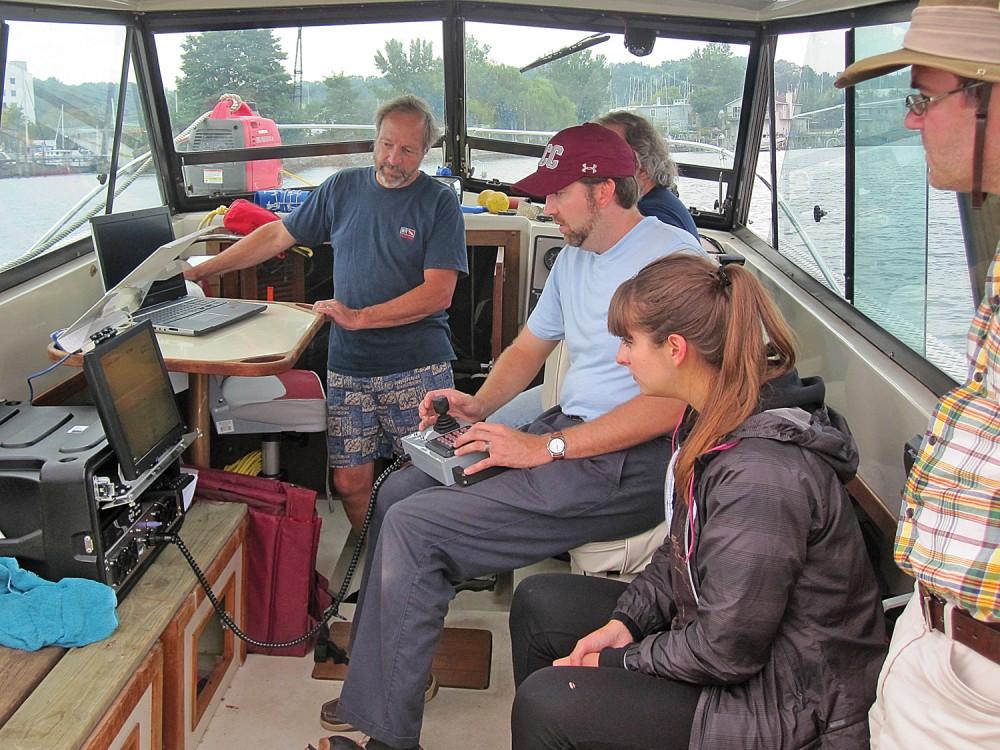Shipwreck study makes waves

Courtesy / David Cummins
Sep 11, 2013
For the past three years, Grand Valley State University professors Mark Schwartz and Mark Gleason have been doing research with GVSU students, but not in the typical setting with beakers of chemicals or lab rats. Instead, the professors are conducting research off the coast of Lake Michigan.
Last weekend, Schwartz, professor of anthropology, and Gleason, visiting professor of hospitality
and tourism management, took three GVSU students out, one each day, to different areas of Lake
Michigan to explore already identified shipwrecks.
On Friday, the team investigated a passenger ship called the State of Michigan that was built in
1873 and sunk in 1901 about four miles northwest of White Lake Harbor, just north of Muskegon.
According to the captain’s report, the ship sunk after a piston rod in the engine broke and
punctured a hole through the ship’s hull.
Saturday, the team planned on surveying an old ore freighter called the Henry Cort off the coast of
Muskegon, but the weather conditions were too windy to conduct the research. The team instead
spent the afternoon driving back and forth on the lake to make a grid of what is on the lake’s
bottom using sonar technology. This type of grid-making is a technique commonly used in
searching for shipwrecks and is a useful skill for anthropology and archaeology students.
On Sunday, the team visited a shipwreck called the Interlaken, which Gleason said was their most
interesting find over the weekend.
“The storms this summer have kind of swept some sand away and exposed artifacts that we haven’t
seen before,” Gleason said. “For example, the engine boiler is much more exposed than it was last
year or the year before.”
Funded by GVSU, the research project this year is a little different from years past. For the first
time, GVSU has formed a coalition with West Michigan Underwater Preserve (WMUP) and Alpena
Community College. The WMUP is a community movement centered on promoting and preserving
the rich maritime history that the West Michigan area has to offer. John Hanson, who is a chairman
of the movement, provided the boat, a 24-foot fisherman, needed for the research.
Schwartz and his crew were able to explore the bottom of Lake Michigan without getting wet,
thanks to a Remotely Operated Vehicle (ROV), which was created specifically for deepwater dives.
“A great thing about these robots is they can go much deeper than the divers can (and) it can stay
down longer than divers can,” Schwartz said. “The utility of these robots is pretty amazing.”
David Cummins, who runs the marine technology department at ACC, provided the ROV, which was
equipped with two cameras, four separate propellers and a sonar device. Although the shipwrecks
have already been identified, the new technology gives Schwartz and his students an advantage
over past researchers.
“These are sights that have been explored by divers, but not necessarily had careful records kept of
them,” Schwartz said. “So it’s an exercise in cultural resource management and historic
preservation, as well as answering questions about the construction of the ships.”
Not only do research trips like this benefit Professor Schwartz, but it also has a huge impact on the
students. Kelsey Hanson, a senior studying anthropology and archaeology at GVSU, was one of the
students invited on the trip.
“I felt that the research trip was a great example of the types of opportunities offered through the
anthropology department,” Hanson said.
Though the trip wasn’t part of the curriculum for any of Hanson’s classes this fall, she volunteered
to join the crew because of her own interests and she hopes it will help her in the future.
“Having the rare opportunity to use and gain experience with various types of underwater survey
equipment will make me a more useful asset to research projects beyond the undergraduate level,”
Hanson said.
Findings made by the team are important for the teachers and the students, but Gleason believes
that they serve another purpose as well.
“I would also say that it’s for the general public because we are able to show things that are
underwater that people are very interested in,” Gleason said.
No matter whom it was for, the research trip was a great success. Gleason and Schwartz said the
coalition of GVSU, ACC and WMUP plans on doing more research together in the future.

























